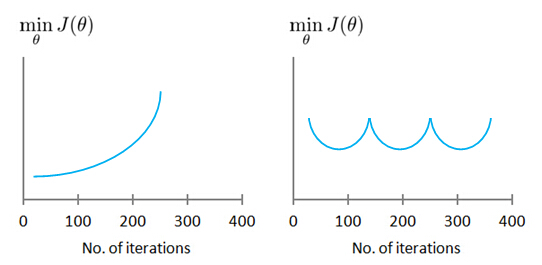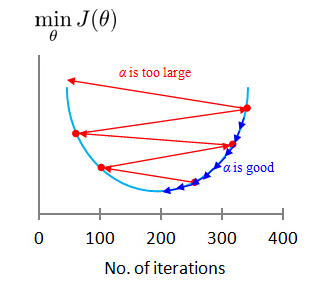This article contains some skills in the implementation of Gradient Descent, including feature scaling, mean normalization and choosing learning rate.
Gradient descent in practice
1. Feature Scaling
Feature Scaling
Idea: Make sure features are on a similar scale, so the gradient descent will converge much faster.
E.g. x1 = size (0-2000 feet2)
x2 = number of bedrooms (1-5)
Get every feature into approximately a -1≤ xi ≤1 range.
These ranges are ok:
These ranges are not good

Mean normalization
Replace xi with xi -μi to make features have approximately zero mean (Do not apply tox0 =1). Where μiis the mean value of feature i.
E.g.
2. Learning rate
Gradient descent

- “Debugging”: How to make sure gradient descent is working correctly.
- How to choose learning rate α .
Making sure gradient descent is working correctly.
- J(θ) should decrease every iteration.
Example automatic convergence test:
Declare convergence if J(θ) decreases by less than 10-3 in one iteration.
- Gradient descent not working: Use smaller α.

- For sufficiently small α , J(θ) should decrease on every iteration.
- But if α is too small, gradient descent can be slow to converge.
Summary:
- If α is too small: slow convergence.
- If α is too large: J(θ) may not decrease on every iteration; may not converge.
To choose α, try: ...,0.001, 0.003, 0.01, 0.03, 0.1, 0.3, 1, ...
3. Matlab Code of Gradient descent with Multiple Variables
function [theta, J_history] = gradientDescentMulti(X, y, theta, alpha, num_iters)
//% X is the training data (design matrix)
//% y is the label of training data (in vector)
//% theta is the vector of parameters
//% alpha is the learning rate
//% num_iters is the number of iterations
//% Initialize some values
m = length(y); % number of training examples
J_history = zeros(num_iters, 1);
for iter = 1:num_iters
//% Perform a single gradient step on the parameter vector theta.
for i = 1:size(X,2)
theta_tmp(i) = theta(i) - alpha*(sum((X*theta-y).*X(:,i)))/m;
end
theta = theta_tmp';
//% Save the cost J in every iteration
J_history(iter) = computeCostMulti(X, y, theta); //% compute J(theta)
end
end
function J = computeCostMulti(X, y, theta)
//% COMPUTECOSTMULTI Compute cost for linear regression with multiple variables
//% Initialize some useful values
m = length(y); % number of training examples
J = 0;
//% Compute the cost of a particular choice of theta
J = 0.5*(X*theta-y)'*(X*theta-y)/m;
end
































 1万+
1万+

 被折叠的 条评论
为什么被折叠?
被折叠的 条评论
为什么被折叠?








